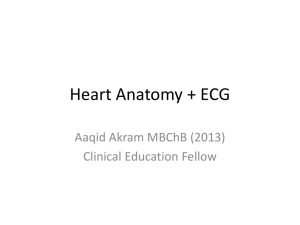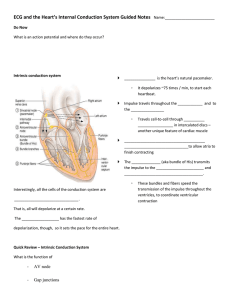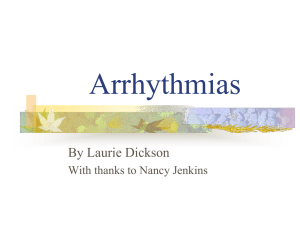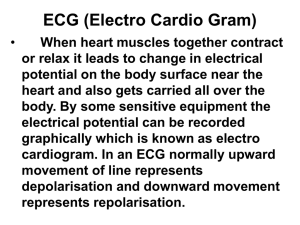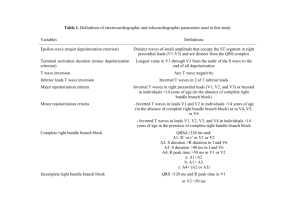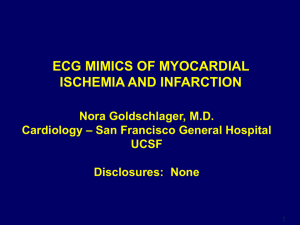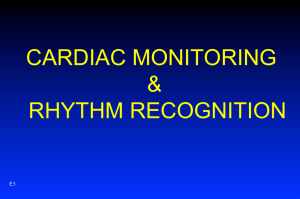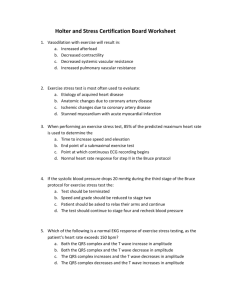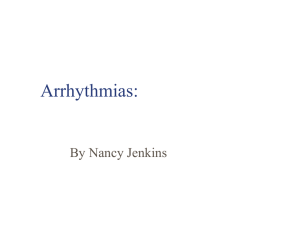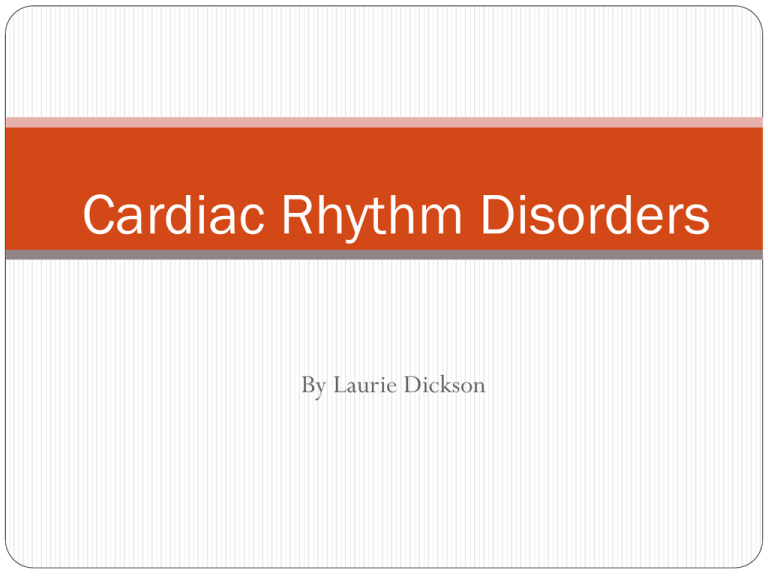
Cardiac Rhythm Disorders
By Laurie Dickson
Electrical System
Each beat that is generated from the same pacemaker will
look identical
Impulses from other cardiac cells are called ectopic (PVC,
PAC)
This electrical activity produces mechanical activity that is
seen as waveforms.
The ECG is the electrical activity of the heart.
Electrical precedes mechanical
Without electricity, we have no pump!!
Action Potentials
Na K pump
Calcium channels
Depolarization
Repolarization
ECG waveforms are produced by the movement
of charged ions across the semipermeable membranes
of myocardial cells.
Normal Cardaic Cycle
Yellow is the isoelectric phase.
The purple is the "P"wave.
The purple and yellow split is the "PR" interval.
The red is the "Q" wave.
The light blue is the "R" wave.
The light green is the "S" wave.
The black is the "ST" segment.
The orange is the "T" wave.
Yellow again is isoelectric.
The dark blue is the "U" wave (seldom seen).
.
Characteristics of Cardiac Cells
Cardiac cells are either contractile cells influencing the
pumping action or pacemaker cells influencing the electrical
activity of the heart
Automaticity
Excitability
Conductivity
Contractility
Refractoriness- Refractory period
Absolute/ Relative/ Full
Refractory Period
Pacemakers other than SA node
A pacemaker from another site can lead to dysrhythmias and
may be discharged in a number of ways.
Secondary pacemakers may originate from the AV node or His-
Purkinje system.
Secondary pacemakers can originate when they discharge more
rapidly than the normal pacemaker of the SA node.
Triggered beats (early or late) may come from an ectopic focus
(area outside the normal conduction pathway) in the atria, AV
node, or ventricles.
Conduction system
SA node 60-100
AV node 40-60
Bundle of His
Left and Right Bundle Branch
Purkinge Fibers 20-40
Nervous System Control
of the Heart
Parasympathetic nervous system: Vagus nerve
Decreases rate
Slows impulse conduction
Decreases force of contraction
Sympathetic nervous system
Increases rate
Increases force of contraction
Risk Factors for Arrhythmias
Hypoxia
Structural changes
Electrolyte imbalances
Central nervous system stimulation
Medications
Lifestyle behaviors
ECG waveforms
P wave = Atrial depolarization (stimulation)
QRS = Ventricular depolarization (stimulation)
T wave = Ventricular repolarization (recovery)
Atrial recovery wave hidden under QRS wave
Stimulus causes atria to contract before ventricles
Delay in spread of stimulus to ventricles allows time for
ventricles to fill and for atrial kick
ECG Monitoring
based on 12 lead ECG
Each lead has positive, negative and ground electrode.
Each lead looks at a different area of the heart.
This can be diagnostic in the case of an MI
ECG leads
Leads to monitor
Best- lead II and MCL or V1 leads- lead II easy to see P
waves. MCL or V1 easy to see ventricular rhythms.
If impulse goes toward positive electrode complex is
positively deflected or upright
If impulse goes away from positive electrode complex is
negatively deflected or goes down form baseline
ECG leads
Lead II positive R arm
looking to LL neg
3 lead placement:
Depolarization wave
moving toward a positive
lead will be upright.
Depolarization wave
moving toward a negative
lead will inverted.
Depolarization wave
moving between negative
and positive leads will
have both upright and
inverted components.
Lead II R arm looking to LL
positive
Five lead placement allows
viewing all leads within
limits of monitor
Grass under clouds, smoke above
fire
V1 is 2nd ICS right of sternum
ECG graph paper
Horizontal measures time
Vertical measures voltage
Helps us determine rate
Width of complexes
Duration of complexes
ECG graph paper
Assessment
Calculate rate
Big block
Little block
Number of R waves in 6 sec times 10
Calculate rhythm-reg or irreg
Measure PR interval, <.20
QRS interval .04-.12
P to QRS relationship
Rate Calculation
1 lg box= .20
5 lg boxes =1 sec
30 lg boxes =6 secs
Therefore there are 300 lg boxes in 1 min.
Sinus Rhythm
Normal P wave- 0.06-0.12 sec
PR interval – 0.12-0.20
QRS- 0.04-0.12
T wave for every complex- 0.16
Rate is regular 60-100
Sinus Tachycardia
Rate >100: Sinus Tachycardia
Causes-anxiety, hypoxia, shock, pain, caffeine, drugs
Treatment-eliminate cause
Clinical significance
Dizziness and hypotension due to decreased CO
Increased myocardial oxygen consumption may lead
to angina
brady heart song
Rate<60: Sinus Bradycardia- relative-symptomatic, absolute-
normal
Cause-vagal stimulation, athlete, drugs (Blockers and digoxin),
head injuries, MI
Watch for syncope
Sinus Bradycardia
Clinical significance-Dependent on symptoms
Hypotension , Weakness
Pale, cool skin
Angina, Shortness of breath
Dizziness or syncope
Confusion or disorientation
Treatment- if symptomatic,
o atropine or pace maker
Sinus Arrhythmia (SA)
Rate 60-100
Irregular rhythm- increases with inspiration, decreases with
expiration
P, QRS,T wave normal
Cause- children, drugs(MS04), MI
Treatment- none
Sinus Arrest
See pauses
May see ectopic beats(PAC’s PVC’s) do not treat
Cause MI
Treatment
atropine
Pacemaker
Medications used to treat
atrial rhythms
diltiazem (Cardizem)
digoxin (Lanoxin)
amiodarone (Cordarone)
dofetilide (Tikosyn)
verapamil (Calan, Calan SR, Covera-HS, Isoptin SR,
Verelan, Verelan PM, Isoptin, Isoptin I.V.)
Premature Atrial Contraction (PAC’s)ectopic
P wave abnormally shaped
PR interval shorter
QRS normal
Cause-age, MI, CHF, stimulants, dig, electrolyte
imbalance
Treatment- remove stimulants and watch for SVT
Paroxysmal Supraventricular
Tachycardia (PSVT)
Rate is 100-300, regular, p often hidden
Ectopic foci in atrium above bundle of HIS
Cause-SNS stimulation, MI, CHF,sepsis
Paroxysmal Supraventricular
Tachycardia (PSVT)
Clinical significance -Prolonged episode and HR >180
bpm may precipitate ↓ CO
Palpitations, Hypotension, Dyspnea, Angina
Treatment Vagal stimulation *
adenosine, B blockers, Calcium channel blockers,
digoxin, amiodarone.
Cardioversion
Atrial Flutter
Rate of atria is 250-300, vent rate varies
Regular rhythm
P waves saw tooth, one ectopi focus
AV block in ratio 2:1, 3:1, 4:1
Flutter waves- No PR interval
Cause-diseased heart, drugs (digoxin)
3:1 flutter
Atrial Flutter
Clinical significance
High ventricular rates (>100) + loss of the atrial “kick” can
decrease CO, precipitate HF, angina
Risk for stroke due to risk of thrombus formation in the
atria
Treatment Calcium channel blockers, Beta blockers
amiodarone, Cardioversion
Ablation
warfarin (Coumadin)
Atrial Fibrillation-most common
Rate of atria 350-600- (disorganized rhythm)
Ventricular response irregular
No P waves, “garbage baseline”
PR cannot measure
QRS- normal
Cause-#1 arrhythmia in elderly, heart disease- CAD,
rheumatic, CHF, alcohol
Atrial Fibrillation
Clinical significance
Can result in decrease in CO due to ineffective atrial contractions
(loss of atrial kick) and rapid ventricular response
Thrombi may form in the atria as a result of blood stasis, travel to
the brain, causing a stroke
Complications- dec. CO and thrombi
stroke risk increases x5
Atrial Fibrillation-most common
Treatment digoxin, Ca channel
blockers, Beta blockers
amiodorone, procainamaide
(Pronestyl)
Cardioversion – warfarin +
TEE
Ablation, Maze
Arrhythmias of AV Node
AV Conduction Blocks
First Degree AV Block
Transmission through AV node delayed
PR interval >.20
QRS normal and regular
Cause- digoxin toxicity, MI, CAD, vagal, and blocker drugs
First-Degree AV Block
Clinical significance
Usually asymptomatic
May be a precursor to higher degrees of AV block
Treatment
Check medications
Continue to monitor
Second Degree AV Block
more P’s than QRS’s
A. Mobitz I (Wenckebach)
PR progressively longer then drops QRS
Cause- MI, drug toxicity
B. MobitzII
More P’s but skips QRS in regular pattern 2:1,3:1, 4:1(QRS
usually greater than .12-BBB)
Constant PR interval- can be normal or prolonged
Occurs in HIS bundle with bundle branch block
Second-Degree AV Block,
Type 1 (Mobitz I, Wenckebach)
Clinical significance
Usually a result of myocardial ischemia or infarction
Almost always transient and well tolerated
May be a warning signal of a more serious AV conduction
disturbance
Treatment- watch for type II and 3rd degree
If symptomatic- atropine, pacer
Diagnosis Wenckebach
Second-Degree AV Block,
Type 2 (Mobitz II)
Clinical significance
Often progresses to third-degree AV block and is associated
with a poor prognosis
Reduced HR often results in decreased CO with subsequent
hypotension and myocardial ischemia
Treatment pacemaker
3rd Degree AV Block
Atria and ventricles beat independently
Atrial rate- 60-100
Slow ventricular rate 20-40
P normal
No PR interval- no relationship with QRS
Wide or normal QRS (depends on where block is)
Cause- severe heart disease, blockers, elderly, MI
Complications- dec. CO, ischemia, HF, shock, and
syncope
Third-Degree AV Heart Block
(Complete Heart Block)
Clinical significance
Decreased CO with subsequent ischemia, HF, and shock
Syncope may result from severe bradycardia or even periods
of asystole
Treatment- atropine, pacemaker
Bundle Branch Blocks
Left BBB
Right BBB
QRS.12 or greater
Rabbit ears- RR’
No change in rhythm
Right Bundle Branch Block
Junctional Rhythm
AV node is pacemaker- slow rhythm (40-60) but very regular
impulse goes to atria from AV node- backward
P wave patterns
Absent
P wave precedes QRS inverted in II, III, and AVF
P wave hidden in QRS
P wave follows QRS
Junctional Rhythm
PR interval
Absent or hidden
Short <.12
Negative or RP interval
QRS normal
No treatment
Ventricular Arrythmias
Most serious
Easy to recognize
Premature Ventricular Contractions
(PVC’s)-ectopic
No P waves
QRS wide and bizarre
T opposite deflection of PVC
Cause- 90% with MI, stimulants, digoxin, electrolyte
imbalance
Premature Ventricular Contractions
Clinical significance
In normal heart, usually benign
In heart disease, PVCs may decrease CO and precipitate angina and
HF
Patient’s response to PVCs must be monitored
PVCs often do not generate a sufficient ventricular
contraction to result in a peripheral pulse
Apical-radial pulse rate should be assessed to determine
if pulse deficit exists
Premature Ventricular Contractions
Clinical significance
Represents ventricular irritability
May occur:
After lysis of a coronary artery clot with thrombolytic
therapy in acute MI—reperfusion dysrhythmias
Following plaque reduction after percutaneous
coronary intervention
PVC’s-unifocal
PVC’s multi-focal
Multifocal- from more than one foci
Bigeminy- every other beat is a PVC
trigeminy- every third beat is a PVC
Couplet- 2 PVC’s in a row
Treat if:
>5 PVC’s a minute
Runs of PVC’s
Multi focal PVC’s
R on T
Treatment- based on cause
O2, lidocaine,
Ventricular Tachycardia (VT)
Ventricular rate 150-250, regular or irregular
No P waves
QRS>.12
Can be stable- pulse or unstable –no pulse
Cause- electrolyte imbalance, MI, CAD, digoxin
Life- threatening, decreased CO, watch for V-fib
Ventricular Tachycardia
Clinical significance
VT can be stable (patient has a pulse) or unstable (patient is pulseless)
Sustained VT: Severe decrease in CO
Hypotension
Pulmonary edema
Decreased cerebral blood flow
Cardiopulmonary arrest
Ventricular Tachycardia
Clinical significance
Treatment for VT must be rapid
May recur if prophylactic treatment is not initiated
Ventricular fibrillation may develop
Treatment- same as for PVC’s and defibrillate for sustained
VT- Torsades de Pointes
French for twisting of the points
Ventricular Fibrillation
Garbage baseline-quivering
No P’s
No QRS’s
No CO
Cause-MI, CAD, CMP, shock, K+, hypoxia, acidosis, and
drugs
Treatment- code situation, ACLS, CPR, **defibrillate
Diagnostic Tests
Telemetry- 5 lead( lead II and V1)
12 lead EKG
Holter monitor- pt. keeps a diary
Event monitoring- pt. records only when having the event
Exercise stress test
Electrophysiology studies- induce arrhythmias under
controlled situation
Nursing Assessment
Apical rate and rhythm
Apical/radial deficit
Blood pressure
Skin
Urine output
Signs of decreased
cardiac output
Nursing Diagnoses
Decreased cardiac output
Decreased tissue perfusion
Activity intolerance
Anxiety and Fear
Knowledge deficit
Goals
Maintain stable signs of effective cardiac output and
tissue perfusion
Achieve a realistic program of activity that balances
physical activity with energy conserving activities
Report decreased anxiety and increased sense of selfcontrol
Describe risk factors, the disease process, and treatment
regimen
Medications
Classified by effect on action potential
Class I- fast Na blocking agents-ventricular
quinidine, procainamide, lidocaine,
disopyramide phosphate (Norpace), propafenone (Rhythmol)
Class II- beta blockers
SVT,Afib,flutter
esmolol, atenolol (Tenormin), propranolol(Inderal)
Medications
Class III- K blocking
both atrial and ventricular
amiodarone, dofetilide, sotalol
Class IV- Ca, channel blockers
SVT,Afib,flutter
verapamil, diltiazem
Other adenosine, digoxin, atropine, magnesium
Antiarrhythmics
Remembering that of all anti-arrhythmics
"some block potassium channels" can help you:
Class I "Some" = Sodium
Class II "Block" = Beta blockers
Class III "Potassium" = Potassium channel blockers
Class IV "Channels" = Calcium channel blockers
Comfort Measures
Rest
O2
Relieve fear and anxiety diazapam (Valium)
Invasive procedures
Defibrillation
Emergency- start at 200 watt/sec, go to 400
Safety precautions
Synchronized Cardioversion- for vent. or SVT
Can be planned- if stable
Get permit
Start at 50 watt/sec
Awake, give O2 and sedation
Have to synchronize with rhythm
cardioversion
Journal of Patient Needing Heart Transplant
My journey started July 13th 2008. Went to doctor thinking I
had bronchitis. 2 days later went in because I got awoken
during the night not being able to breath. Dr thought I had
gone into pneumonia, gave chest xray,18th go back tells me I
have congestive heart failure, starts me on water pills and
something else has me scheduled for an echo on Monday, wait
2 days calls and wants me to come in on Friday and wants a
cardiologist to see me and the echo, go in tells me to go to a
hospital north of us saying they have a room ready and will
schedule a cath and the cardiologist can reveiw the echo. get
up there doc reviews echo, while nurses are hooking me up
with IVs, Dr comes in and says may have major heart damage
but will wait until cath on Monday. Monday comes have cath a
surgeon comes in with cardiologist telling us I have over half
my heart damaged may need transplant, cardiologist says
they would rather transport me to a major hospital that can
handle transplant surgery if something goes wrong with
bypass. EF is 15%. go to Indianapolis by ambulance,
I am in total shock by this point not being able to even
comprehend what is going on 2 weeks from going from
bronchitis or so I thought to maybe having heart transplant.
My wife god bless her is having her own stress out of her
mind over this. get to Indy Tues and Wed nuclear test, Friday
high risk bypass surgery.
Now its 6 weeks after surgery have had another echo EF
went up a whopping 5% now getting defibbed Tuesday, today
is Sunday and again my mind is wondering into the worst
scenarios, it is getting harder and harder to grasp this stuff.
hopefully sites like this will help, letting blow off steam, and
learning.
Dave
ICD Implanted defibrillator Device
Senses rate and width of QRS
Goes off 3 times, then have to be reset
Combined with pacemaker- overdrive pacing or backup pacing
Indications for ICD
Survived SCD
Spontaneous sustained V Tach
Syncope with V Tach/V Fib
High risk for life threatening dysrhythmia
ICD teaching
Avoid lifting arm on ICD side above shoulder until approved
by PCP
Avoid driving until cleared by PCP
Avoid large magnets and strong electromagnetic fields (no
MRI)
If the ICD fire, call health care provider
If ICD fires and they do not feel well, call EMS
If ICD fires more than once, call EMS
Caregivers should know CPR
ICD resources
Pacemaker
Used to pace the heart when the normal
conduction system is damaged
Permanent battery under skin
Temporary battery outside body
Types
Transvenous
Epicardial- bypass surgery
Transcutaneous- emergency
Pacemaker
Modes
Asynchronous- at preset time without fail
Synchronous or demand- when HR goes below set rate
Classifications
Indications for pacemaker
AV block
A-Fib with slow ventricular response
Bundle Branch Block
Cardiomyopathy
Heart failure
SA node dysfunction
Tachydysrhythmias (V Tach)
Teaching Similar to ICD
Daily Pulse
Pacemaker Problems:
Failure to sense
Failure to capture
Ablation
Done in special cardiac procedures lab
Use a laser to burn abnormal pathway
radiofrequency ablation
ECG Changes Associated with Acute
Coronary Syndrome (ACS)
Ischemia
ST segment depression and/or
T wave inversion
ST segment depression is significant if it is at least 1 mm (one
small box) below the isoelectric line
ECG Changes Associated with Acute
Coronary Syndrome (ACS)
Fig. 36-29 A
Copyright © 2007, 2004, 2000, Mosby, Inc., an affiliate of Elsevier Inc. All Rights Reserved.
ECG Changes Associated with Acute
Coronary Syndrome (ACS)
Injury/Infarction
ST segment elevation is significant if >1 mm above the
isoelectric line
If treatment is prompt and effective, may avoid infarction
If serum cardiac markers are present, an ST-segment-elevation
myocardial infarction (STEMI) has occurred
ECG Changes Associated with Acute
Coronary Syndrome (ACS)
Injury/Infarction
Note: physiologic Q wave is the first negative deflection
following the P wave
Small and narrow (<0.04 second in duration)
Pathologic Q wave is deep and >0.03 second in duration
EKG changes in an acute MI
ECG Changes Associated with Acute
Coronary Syndrome (ACS)
Fig. 36-29 B
Copyright © 2007, 2004, 2000, Mosby, Inc., an affiliate of Elsevier Inc. All Rights Reserved.
ECG Changes Associated with Acute
Coronary Syndrome (ACS)
Fig. 36-30
Copyright © 2007, 2004, 2000, Mosby, Inc., an affiliate of Elsevier Inc. All Rights Reserved.
ECG changes with ACS
The 12-lead ECG is the primary diagnostic tool used to evaluate
patients presenting with ACS.
There are definitive ECG changes that occur in response to
ischemia, injury, or infarction of myocardial cells and will be seen
in the leads that face the area of involvement.
Typical ECG changes seen in myocardial ischemia include STsegment depression and/or T wave inversion.
The typical ECG change seen during myocardial injury is STsegment elevation.
An ST-segment elevation and a pathologic Q wave may be seen on
the ECG with myocardial infarction
Syncope
Brief lapse in consciousness accompanied by a loss of tone
(fainting)
Causes
Cardiovascular
Vasovagal, Cardiac dysrhythmias, hypertrophic
cardiomyopathy , PE
Noncardiovascular
hypoglycemia, seizure, hysteria, TIA
Syncope
Diagnostic studies
Echocardiography
EPS
Head-upright tilt table testing
Holter monitor
Subcutaneously implanted loop recording device
1-year mortality rate as high as 30% for syncope from
cardiovascular cause
Complications of Arrhythmias
Hypotension
Tissue ischemia
Thrombi- low dose heparin, or ASA
Heart failure
Shock
Death
Prioritization Question
A client with atrial fibrillation is ambulating in the hall on
the coronary step-down unit and suddenly tells you, “I
feel really dizzy.” which action should you take first?
A. Help the client sit down.
B. Check the client’s apical pulse
C. Take the client’s blood pressure
D. Have the client breathe deeply
Prioritization question
A diagnosis of ventricular fibrillation is identified for an
unresponsive 50 year old client who has just arrived in
the ED. Which action should be taken first?
A. Defibrillate at 200 joules
B. Begin CPR
C. Administer epinephrine 1 mg IV
D.Intubate and manually ventilate.
Prioritization question
Cardiac rhythms are being observed for clients in the CCU. Which
client will need immediate intervention? A client:
A. admitted with heart failure who has atrial fibrillation with a
rate of 88 while at rest.
B. with a newly implanted demand ventricular pacemaker, who
has occasional periods of sinus rhythm, rate 90-100.
C. who has just arrived on the unit with an acute MI and has sinus
rhythm, rate 76, with frequent PVC’s.
D. who recently started taking atenolol (Tenormin)) and has a
first-degree heart block rate 58.
Video Acting Out Rhythms
mad german doctor dances to heart rhythms
Practice-
http://www.skillstat.com/Flash/ECG_Sim_2004.html
Casestudies
QuizzesDiscussionQuestions


